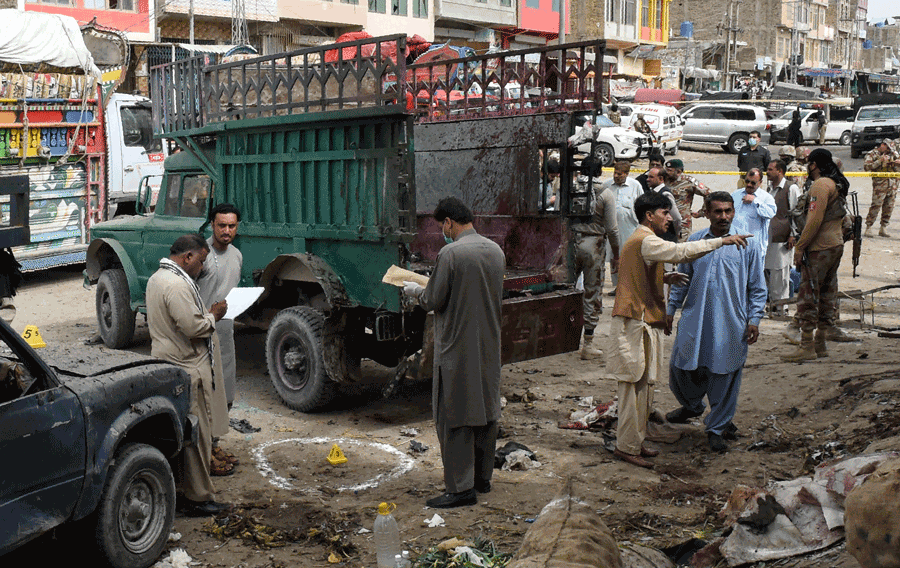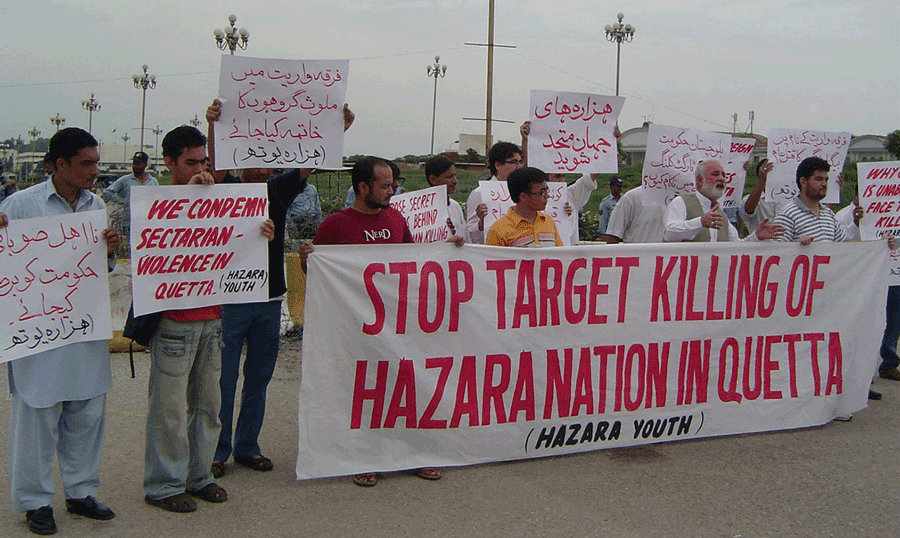The Sectarian Nightmare
By Ali Arqam | Newsbeat National | Published 6 years ago

Afternoon of terror: Pakistani security officials inspect the site of a bomb blast targeting the Hazara minority at a fruit market in Quetta.
A new wave of sectarian-fuelled target killings swept across Karachi in January and February this year, including an assassination attempt on the renowned Sunni scholar and former judge of the Federal Shariat Court, Mufti Taqi Usmani. Karachi, which had witnessed an improvement in law and order over the last five years after operations conducted by the law enforcement authorities (LEAs), has once again spiralled out of control.
Members of two sectarian groups – the Majlis Wahdate-e-Muslimeen (MWM), a political organisation of the Shia sect and the Ahle Sunnat Wal Jamat (ASWJ), a Sunni group formerly known as Sipah-e-Sahaba Pakistan (SSP) – were among those targeted. Fida Hussain, a 55-year-old trader who belonged to the Shia group, was hit on January 3 outside his medical store near Al-Shifa Clinic, in Zaman Town, Korangi, by unknown assailants riding a motorbike. Hailing from Gilgit Baltistan, the deceased was the father of an office-bearer of the Imamia Students Organisation in Korangi. MWM termed it an act of sectarian killing. Two workers of the Sunni group, the ASWJ, meanwhile, received bullet injuries after being attacked near Al-Asif Square, Sohrab Goth. The two victims were identfied as 33-year-old Abdul Wahid and 27-year-old Momin Shah, both teachers at a local madrassa, who were attacked while returning home after attending an ASWJ event.
On January 22, Mohammad Ali Shah, 46, was targeted at close range by assailants on a motorbike, when he stopped at a traffic signal near Noorani Kabab, PECHS. The victim was an officer of the Karachi Development Authority (KDA), belonged to the Shia sect and was associated with the Shia Ulema Council.
On February 3, a 30-year-old trader Nadeem Yasin Qadri, was also killed by armed motorcyclists near Shahabuddin Market, Saddar. The victim was the ASWJ’s Liaquatabad Town president.
The assassination bid rang alarm bells for the LEAs. The Chief Minister Sindh, Syed Murad Ali Shah, issued instructions to the LEAs to conduct a rigorous operation against terrorists and outlaws. The LEAS have, in response, accelerated their intelligence-based operations and raids on militant hideouts, and increased surveillance of sleeper cells. These activities were followed by claims of the capture and killing of militants associated with proscribed organisations.
The violence, however, is not confined to Karachi. The first four months of 2019 have witnessed a surge in terrorism and violence across Pakistan. In April alone, the bombing of a fruit market in Hazarganji, Quetta, killed 20 people, including eight Hazaras and injured more than 40. A few days later, 14 members of the security forces travelling from Karachi to Gwadar by bus were massacred in Ormara, Balochistan, by Baloch separatists.
Explaining the recent surge in sectarian-driven violence in Karachi, officials of the Counter-Terrorism Department (CTD) said that many absconding members of proscribed sectarian groups have returned to the city in recent times, while those who were previously behind bars, have been released on bail. They have, as a result, re-started their activities.
In the past few weeks the CTD claimed to have arrested a key member of the terrorist group Jundullah and busted a cell of Islamic State that was involved in recruitment activities through social networking sites. Additionally, the head of the CTD’s transnational terrorism intelligence group, Raja Umer Khattab, also claimed to have nabbed six members of the Sipah-e-Muhammad, a Shia militant group.
Explaining the recent surge in sectarian-driven violence in Karachi, officials of the Counter-Terrorism Department (CTD) said that many absconding members of proscribed sectarian groups have returned to the city in recent times, while those who were previously behind bars, have been released on bail. They have, as a result, re-started their activities. Mufti Taqi Usmani, however, blamed the enemies of Pakistan and not sectarianism for his attempted assassination.
Yet the biggest breakthrough of the year so far, took place on February 28, when the Shikarpur police, killed two Shikarpur-based militants: the Islamic State’s Sindh Emir, Abdullah Brohi and his deputy, the notorious Abdul Hafeez Pandrani in the Dadhar area of Balochistan (north-west of Shikarpur). The Sindh Police Counter-Terrorism Department (CTD) had announced head money on both the militants.
The ‘Pakistan Security Report 2018,’ by the Islamabad-based think tank, Pakistan Institute of Peace Studies (PIPS), had cited the Hafeez Brohi group as a threat. The group was involved in attacks on Shia mosques and Ashura processions in Shikarpur and Jacobabad, and an attack on the shrine of the revered saint, Lal Shahbaz Qalandar in Sehwan Sharif.
The PIPS report contained detailed statistics on incidents of violence and terrorism for the year 2018, and showed that the year marked a significant decline in terrorist attacks across Pakistan. Whereas there was a 29 per cent decline in the incidents of attacks, fatalities also fell by 27 per cent, as compared to 2017.
The report had, very rightly, raised an alarm regarding the Tehreek-e-Taliban Pakistan (TTP) and IS as a potent threat to Pakistan’s security. Balochistan, where IS has been very active, meanwhile, did not see a reduction in terror attacks and fatalities. It instead witnessed a 23 per cent rise in the number of people killed in attacks by the militants. The report stated that 38 per cent of the 595 people killed in acts of terrorism in the year 2018, were victims of five lethal attacks claimed by IS.
The attack on Mufti Taqi Usmani, too, may have been carried out by disgruntled militants who are unhappy with the stance of the Usmani brothers-run seminary on the Asia Bibi blasphemy case verdict by the Supreme Court of Pakistan. Mufti Rafi Usmani, the principal of Darul Uloom in Korangi and the elder brother of Mufti Taqi Usmani, spoke in favour of the verdict. It is also believed that one of the reasons why Taqi Usmani may have suffered the wrath of IS is because of his involvement in the peace talks with the Afghan Taliban. He had, in a statement issued through his Twitter account, requested that the attack must not be linked to sectarianism. He termed it an act by the enemies of Pakistan, to create unrest prior to Pakistan Day (March 23), and said that two of his police guards had lost their lives protecting him, while two other companions had sustained bullet injuries.
The LEAs, however, have not ruled out the possibility of the involvement of elements belonging to the Shia militant outfit Sipah-e-Muhammad Pakistan (SMP) in the attack on Taqi Usmani. In February, the Anti Violent Crime Cell (AVCC) of the Karachi Police claimed to have arrested a suspected target killer allegedly involved in the assassination of Mufti Abdul Majeed Deenpuri, a Sunni cleric of the Jamiatul Uloom-ul-Islamia, in Binori Town. The 60-year-old cleric, who was the head of Darul Iftaa in the seminary, was shot dead in January 2013 along with two other clerics – Hasan Shah and Mufti Salih Muhammad – on Shahrah-e-Faisal. The suspect was identified as Syed Shahadat Hussain, alias ‘Pir.’
Interestingly, an accused linked to the Muttahida Qaumi Movement-London (MQM-L) has already been convicted in the same case and was awarded the death sentence by an Anti-Terrorism Court (ATC) in November 2018. The convict, Ali Hassan Zaidi, was charged with the murder of Mufti Abdul Majeed Deenpuri and two others and was arrested by the Rangers from Jacob Lines in December 2013, according to a Rangers spokesperson.
Syed Wasi Hyder, another accused who was linked to the MQM, was arrested in September 2015 from Karachi’s Federal B Area and charged with the murder of several religious scholars, including Mufti Nizamuddin Shamezai and Mufti Abdul Majeed Deenpuri. The home department had placed head money of Rs 5 million on Hyder.
Based on data acquired through the geofencing of vicinities around the area where Taqi Usmani was attacked, LEAs have nabbed several persons and claimed to have made a breakthrough in the investigation.
On April 15, the Deputy Inspector General (DIG) CTD, Abdullah Shaikh had, in a press conference, claimed that the Transnational Terrorism Intelligence Group (TTIG) had apprehended six militants linked to the SMP. One of these was a serving police constable named Haider Abbas Rizvi, while the other two, Mohammed Haider alias ‘Chota’ and Syed Mehtab Husain alias ‘Machar,’ are listed in the CTD’s Red Book of most wanted militants. The remaining three are Gul Akbar alias Abdullah, Asif Raza alias Khalid and Kamran alias Pathan. It has also been claimed that they received funding from foreign elements through other absconding militants, namely Zahoor Mehdi and Syed Waseem Ahsan Naqvi. The name of the latter is also in the Red book. It is said that these militants have confessed to their involvement in attacks on the leaders as well as members of rival sectarian groups.
Rashid Rizvi, the head of the committee for Shia Missing Persons’ Families, says that the claims of the Counter-Terrorism Department and Umer Khattab should be taken with a pinch of salt. According to Rizvi, the law enforcement authorities have falsely implicated 23 Shias in cases of target killings and have picked them up from their homes in the last couple of months. Most of them have no militant background, while those of them who were previously associated with the SMO have been released in the past after facing similar charges.
Rashid Rizvi, the head of the committee for Shia Missing Persons’ Families, emphasises that these claims by the CTD and Umer Khattab (the head of the TTIG), should be taken with a pinch of salt since the LEAs have falsely implicated 23 Shias in cases of target killings and have picked them up from their homes in the last couple of months. Most of them have no militant background, while those of them who were previously associated with the SMO have been released in the past after facing similar charges.
At the moment, there is no network of the SMP and all the charges would have been proven false had these individuals been presented before the court. Rizvi accused the LEA officials, especially the head of TTIG, of bias, and said if he had been neutral, he would have nabbed the killers of Khurram Zaki and Askari Raza. Instead no one has been arrested or charged for their murders, despite the passage of several years.
Another activist from the committee of Shia Missing Persons’ Families alleged that the Shia activists were being punished for their campaign against Saudi Crown Prince Mohammed Bin Salman, during his visit, and have been falsely accused. An official of the CTD refused to comment on these accusations and referred to the recent operations in which militants linked to Jundullah and IS were also arrested.
Meanwhile, two journalists, Daily Jang reporter Matloob Hussain Mosavi and Abb Takk News cameraman Syed Ali Mubashir Naqvi, were also picked up on March 30 and April 1, respectively, for unknown reasons. Mosavi’s detention was earlier linked to the attack on Taqi Usmani, and it was alleged that he had been picked on the basis of geofencing data – a claim that was later ruled out. A statement by the Reporters Sans Frontieres (RSF) termed their abduction an act of intimidation and hinted that criticism of the Saudi Crown Prince during his Pakistan visit in February this year might have been the cause of it. The RSF too has referred to the Shia connection in both cases.
Ali Arqam main domain is Karachi: Its politics, security and law and order


